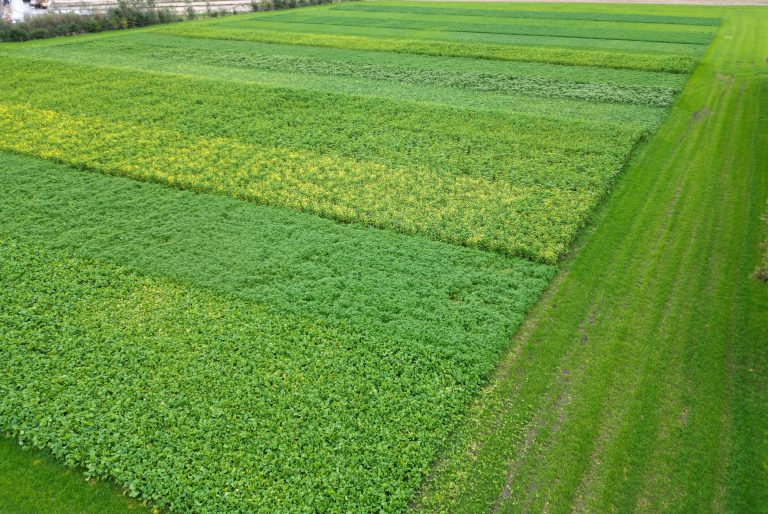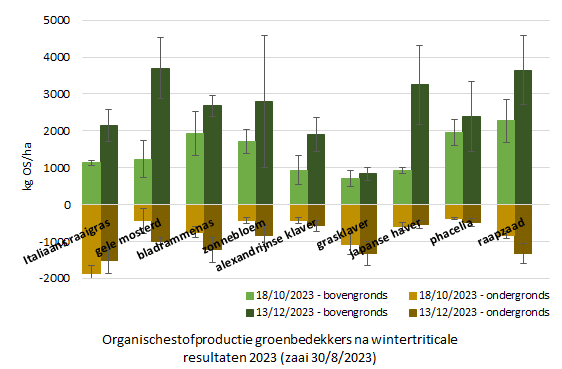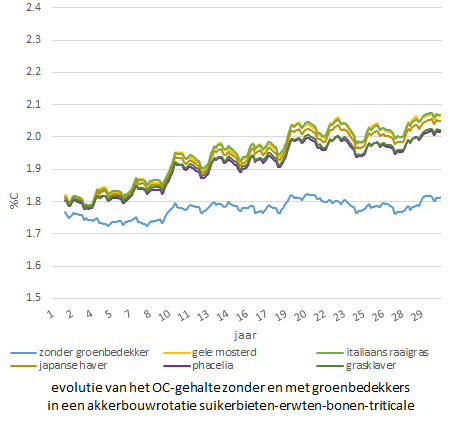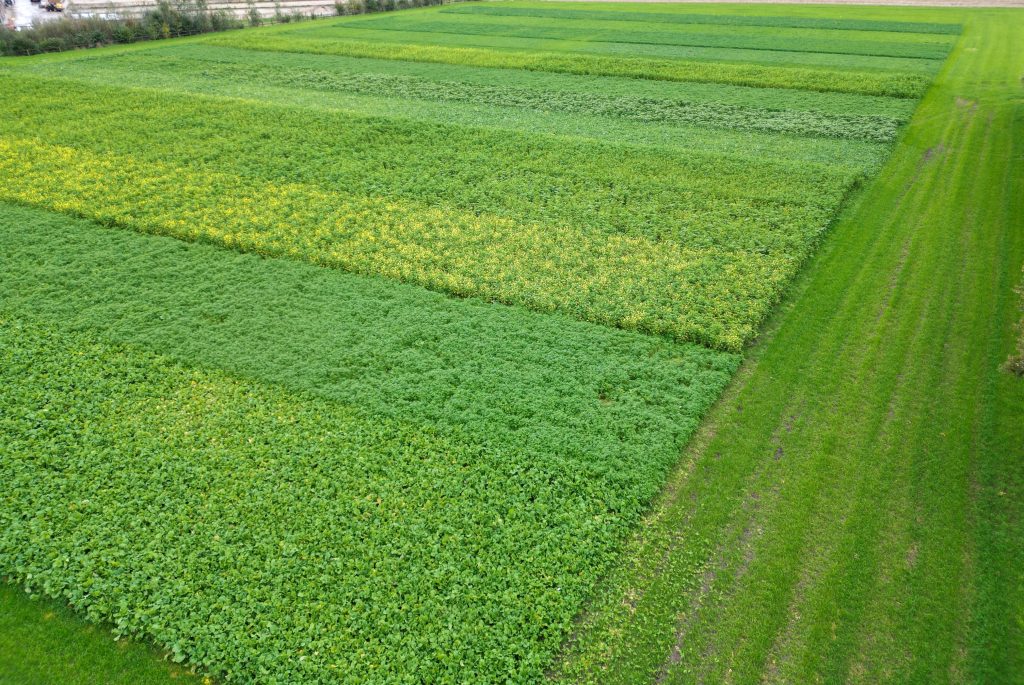Over the past three decades, farmers, including from a policy perspective, have already implemented many interventions that have improved water quality, although this improvement has stagnated over the past 10 years. On sandy soils, a decrease in organic matter content is also observed. Boosting this again will have a positive impact on soil quality, soil water retention capacity, crop yields and nutrient losses.
An important measure farmers can apply to improve soil organic matter content while avoiding the loss of valuable nutrients during winter is sowing green cover crops after harvest. For instance, green cover crops are known to absorb and retain residual nutrients after the harvest of the main crop, hence the term catch crops is also regularly used. However, green cover crops not only retain nutrients, but also introduce fresh organic matter into the soil, thus increasing organic matter content. From this point of view, we wanted to find out what effective organic matter production can be achieved by different types of green cover crops, both above- and below-ground.
Within the Leader project 'Water quality, an integrated approach', a pilot field was therefore set up in 2023 with different types of green cover on which biomass measurements and soil analyses were carried out. This year, this trial will be repeated and complemented by a demonstration on incorporation of green cover crops in spring 2025.
Green coverings: types and functions
In practice, there are numerous different types of green cover crops, each with their own specific characteristics and strengths in terms of soil cover, nutrient uptake, effective organic matter supply and nutrient release. They can be broadly classified into three groups. Moreover, by mixing different species, the best assets of different species can be combined.
Leafy green cover plants, such as yellow mustard, leaf radish and phacelia, exhibit rapid and pronounced above-ground growth, allowing them to absorb N quickly and also provide rapid ground cover. However, these crops are often frost-prone and die in winter. Because they mainly produce above-ground biomass with a low C/N ratio and consequently degrade rapidly, absorbed nutrients are quickly released again after dying off and their contribution to resistant or effective soil organic matter (EOS) is smaller.
Grassy green covers, such as Italian ryegrass, cut rye and Japanese oats, have slow initial growth, which means they do not cover the soil and take up meaningful amounts of N until later. However, because they are often not or only moderately sensitive to frost (except Japanese oats), they continue to grow and take up nutrients during and after winter. They have pronounced root development, which also makes them interesting for erosion control. The C/N ratio of their crop residues is higher and degradability lower, which after dying off and incorporation ensures a slow release of absorbed N and an important contribution to resistant soil organic matter.
Butterfly-flowered green cover plants, such as clover, Alexandrian clover and vetch, provide sequestration of N2 from the atmosphere and thus act mainly as green manures and, to a lesser extent, as catch crops. They have moderately rapid to rapid above-ground growth, moderate to intensive rooting and their frost sensitivity also varies from species to species. Their low C/N ratio ensures that, after dying off and incorporation, the crop residues break down quickly and the absorbed N is released quickly.
Demo plot
At the demo plot in 2023, a very wide range of green cover crops was established, with hardy and frost-sensitive species, leafy and grassy species, mixtures, etc.

Effects on soil organic matter build-up
Both above- and belowground application of fresh organic matter in the form of plant biomass was measured in the demo plots.
The figure below shows the results of the biomass measurements of the different green cover crops, expressed in kg organic matter per hectare. The brown bars downwards represent the underground biomass; the green bars upwards represent the above-ground biomass. The green cover crops were sown on 30 August and biomass measurements were made on 18 October (light coloured bars) and 13 December (dark coloured bars).
Most broad-leaved green cover crops (except yellow mustard, cause unclear) had a significantly higher above-ground biomass in October than grassy green cover crops (Italian ryegrass, grass-clover, Japanese oats) and clover, while below-ground biomass was higher for Italian ryegrass and also some grass-clover.
By December, both yellow mustard and Japanese oats had caught up in above-ground biomass, while below-ground, leaf radish and turnip rape, thanks to their deep taproot, now had more root biomass on average.
We emphasise here that the figure shows the results of only 1 year (2023). Moreover, the winter of 2023-2024 had no real frost period, which allowed the green cover to continue to grow after the last measurement.
In autumn 2024, a new trial was constructed and new measurements will be taken, which will allow us to show annual effects (weather conditions) on this biomass production.

The long-term effects of green cover crops on soil organic matter composition were estimated from Cslim simulations. The figure below compares an arable rotation on sandy soil with sugar beet, peas and beans and triticale without green cover crops with the same rotation with different green cover crops. In these simulations, the amounts of crop residues supplied by the green cover crops were estimated from the trial field measurements. In terms of long-term soil organic matter composition, there are small differences between the green cover crops (based on the trial field measurements in 2023!), but it is clear that using green cover crops in the crop rotation can make a significant contribution anyway.

Effects on nitrogen fixation during winter and nitrate residue
In autumn (18 October), both nitrogen uptake by green cover crops and nitrate residue were measured in the field. The results are presented in the figure below. On average across all green cover crops, a nitrogen uptake of 76 kg N/ha was achieved.
The differences between the green cover crops were more or less analogous to these of biomass production: by 18 October, the broad-leaved green cover crops leaf radish, phacelia and turnip rape had absorbed the most nitrogen (85 to 120 kg N/ha). Italian ryegrass also performed far from poorly (80 kg N/ha). Nitrogen uptake of the other green cover crops was lower on average, but was still around 50 kg N/ha.
The nitrate residue on 18 October partly (but not always) reflected the differences in nitrogen uptake between green cover crops: the greater the N uptake the smaller the nitrate residue.

Decision
As expected, the positive effects of green cover crops were confirmed both on soil organic matter composition and residual nitrogen uptake in the field trials and long-term simulations. Based on 1 crop year, the field trials also already show some interesting differences in terms of organic matter production. By repeating this trial, these results will be reinforced which should lead to concrete advice on the choice of green cover in function of carbon build-up in the soil.
Mia Tits (Soil Science Service of Belgium), Lore Luys and Bart Swennen (Agricultural Research and Training Centre)








